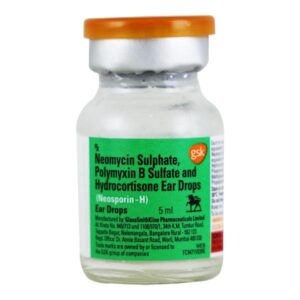NEOMYCIN + HYDROCORTISONE + POLYMYXIN-B
Neomycin: Neomycin is an antibiotic drug that is commonly used to treat and prevent bacterial infections. It belongs to the class of drugs known as aminoglycosides. Neomycin works by inhibiting the growth and production of bacteria by interfering with their protein synthesis.
Neomycin is primarily used topically to treat skin and wound infections, as well as to prevent infections in surgical procedures. It is also available as an oral formulation and can be used to treat gastrointestinal infections, particularly those caused by Escherichia coli.
The appropriate dose of neomycin depends on the specific condition being treated. For topical use, it is generally applied directly to the affected area multiple times a day. When taken orally, the dosage is typically determined based on the patient’s weight and the severity of the infection.
While neomycin is generally well-tolerated, it may cause some side effects. Common side effects include skin irritation, itching, and redness at the application site. When used orally, neomycin can also cause nausea, vomiting, diarrhea, and abdominal cramps. In rare cases, neomycin may cause severe allergic reactions, such as difficulty breathing or swelling of the face, lips, or tongue. It is important to consult a healthcare professional if any adverse effects occur.
It is worth noting that neomycin should be used with caution in individuals with kidney problems or hearing impairment, as it can potentially cause further damage. Additionally, neomycin should not be used in individuals with known hypersensitivity to aminoglycosides or in those with a history of allergic reactions to neomycin.
As with any medication, it is important to follow the dosage and usage instructions provided by healthcare professionals.
Hydrocortisone: Hydrocortisone is a medication that belongs to the class of drugs called corticosteroids. It is used to treat various conditions involving inflammation, such as allergic reactions, asthma, rheumatoid arthritis, and skin conditions like eczema and psoriasis. It can be taken orally, applied topically as a cream or ointment, or administered as an injection.
The mechanism of action of hydrocortisone involves its ability to reduce inflammation and suppress the immune response in the body. It works by inhibiting the production of certain substances in the body that are responsible for inflammation, such as prostaglandins and cytokines. This helps to alleviate symptoms like swelling, redness, itching, and pain.
The dose of hydrocortisone varies depending on the form of the medication and the condition being treated. Oral tablets are usually taken once or twice a day, typically in the range of 20-240 mg per day. When used topically, the cream or ointment is applied to the affected area in a thin layer, usually 2-4 times a day. The exact dose should be determined by a healthcare professional based on the individual’s condition and response to treatment.
As with any medication, hydrocortisone may have side effects. Common side effects of oral hydrocortisone may include increased appetite, weight gain, insomnia, mood changes, and elevated blood pressure. Prolonged use of high doses can potentially lead to more serious side effects like adrenal suppression, osteoporosis, and increased susceptibility to infection.
Topical hydrocortisone can also cause side effects such as skin thinning, burning, itching, or a change in skin color. It is important to follow the instructions provided by the healthcare professional and to use this medication only as directed. If any severe or persistent side effects occur, it is advisable to seek medical attention.
Polymyxin-B: Polymyxin-B is a medication that belongs to the class of antibiotics known as polymyxins. It is primarily used to treat infections caused by Gram-negative bacteria, particularly those that are resistant to other antibiotics.
The main mechanism of action of polymyxin-B is its ability to disrupt the outer membrane of bacterial cells, leading to cell death. It binds to and disrupts the structure of lipopolysaccharides (LPS), which are important components of the outer membrane of Gram-negative bacteria. This disruption causes the release of intracellular contents and eventually leads to bacterial cell death.
Polymyxin-B is available in various forms, including as an injection, ointment, and eye drops. The dosage and duration of treatment depend on the type and severity of the infection being treated, as well as individual patient factors. It is typically administered by a healthcare professional, either intravenously or topically.
As with any medication, polymyxin-B can cause side effects. Some common side effects of polymyxin-B include allergic reactions, such as rash, itching, or swelling, as well as pain or irritation at the injection site. In rare cases, it may cause more severe side effects, such as kidney damage or nerve damage. It is important to report any unusual or severe side effects to a healthcare professional promptly.
It is essential to note that polymyxin-B should only be used under the guidance of a healthcare professional, as it is a potent antibiotic and should not be used indiscriminately. Additionally, it should not be used as a first-line treatment unless other antibiotics are ineffective or contraindicated due to bacterial resistance or individual patient factors.

